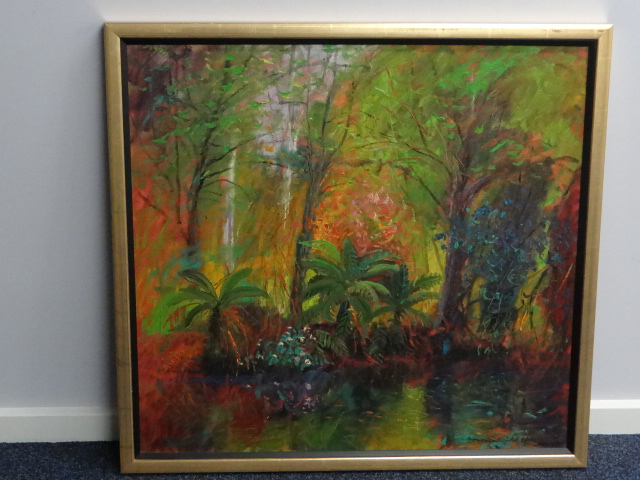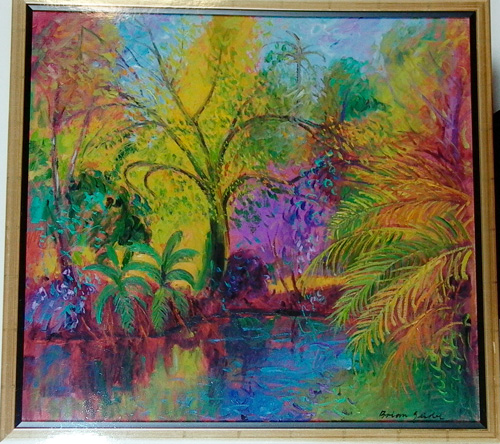Brian Seidel, Autumn Pond and Tropical Pond
BRIAN SEIDEL (Australian, 1928-2019)
Tropical Pond 1995 Oil on Canvas #dimensions 71cm x 76cm #dimensions (framed) Acquired # #Inventory/Catalogue No. |  |
BRIAN SEIDEL (Australian, 1928-2019)
Autumn Pond 1995 Oil on Canvas #edition #dimensions (image) : 71cm x 76cm #dimensions (framed) Acquired # #Inventory/Catalogue No. |  |
Biography:
Brian Seidel was a post-war Australian artist renowned for his decorative paintings and prints of semi-abstract landscapes, interiors and street scenes.
Seidel began his arts education at Goodwood Technical High School where he studied under the eminent Jeffrey Smart. On the advice of Smart Seidel took up teaching at Adelaide Teachers College as a means to secure an education at the school whilst establishing an income, and he continued to dually engage in the world of art and art education until the 1980s. Particularly at the beginning of his career, Seidel explored avenues such as theatrical set design and printmaking, both with significant success.
From the 1940s to 1960s, Seidel’s work covered a wide range of subject matter: figure studies, still-lifes, topographical studies of regional towns and on-site landscapes.[1] The eighteen month period from 1961 spent at the University of Iowa and in Europe was decisive in shaping Seidel’s future output. He was exposed to Iowa’s cool climate resulting in a much celebrated series of paintings exploring the white and dark palettes of snowscapes, and also found himself at the scholarly centre of the debate on art theory.[2] Seidel’s work became increasingly abstracted and shed the romanticism of his early work.
After the breakdown of his marriage, Seidel sought solace in his art and personal relations and returned to painting the human form. By the 1960s he had developed a recognisable style: his interiors depicted a space with a figure or figures against which is contrasted an exterior sunlit view through a doorway, with sunlight used to highlight or marr the subject’s details.[3]
Notably Seidel was one of seven artists invited by the Commonwealth Art Advisory Board to participate in the 1963 Biennale de Jeunes at the Musée d’Art Moderne and enjoyed critical appreciation especially in Sydney and Canberra rather than his hometown, Adelaide.[4] He dedicated himself to full-time painting in the late 1960s, however in 1971 became Head of the School of Art and Design at Preston Institute of Technology. Seidel took a year’s leave in 1974 to travel, and in 1977-8 worked as Artist-in-Residence at Griffith University. These experiences confirmed to Seidel his wish to return to full-time painting, and he left the teaching post in 1981. Seidel continued to paint until his death in 2019 and travelled extensively to Europe and the United States, notably in his trip to Central Australia with John Brock.
The artworks:
Seidel’s oeuvre is typified by his delight in the tactile quality of paint and his unwillingness to fit into either abstract or figurative conventions, and ‘Tropical Pond’ and ‘Autumn Pond’ are good examples of these principles. Seidel’s contemporaries in Adelaide, most notably Shannon, Cleland, and Dallwitz were exploring ways of interpreting landscape compositions in light of modernist experiments abroad and Seidel’s two paintings similarly play keenly with colour and layering to capture a sense of deep light, warmth and sun, mood and movement in the fecund tropical scene.
Bibliography:
Berko, N., Art and Artists of South Australia, Adelaide, Lidums, 1969
Bonython, K., Modern Australian Painting 1960- 1970, Adelaide, Rigby, 1970
McCulloch, A., & McCulloch, S., The Enclyclopedia of Australian Art, Allen & Unwin, St Leonards, 1994
McKenzie, J., Drawing in Australia, Melbourne, Macmillan, 1986
Quartermaine, P., Brian Seidel: landscapes and interiors, Beagle Press, Sydney, 1993
Further reading:
Seidel, B., The Arts in Australia, Printmaking, Melbourne, Longmans, 1965
[1] Quartermaine, P., Brian Seidel: landscapes and interiors, Beagle Press, Sydney, 1993, p. 67
[2] Ibid., p. 68
[3] Ibid., p. 70
[4] Ibid., p. 71

